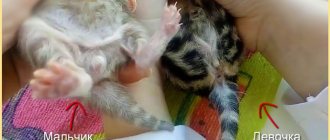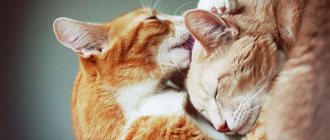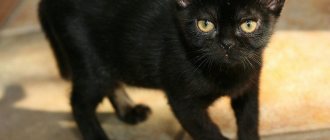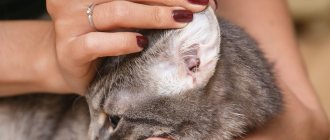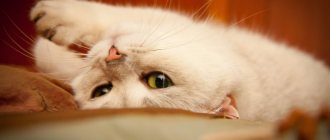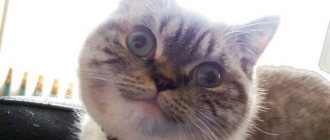Practice ALL ARTICLES 6307
How often do you say “meow” to your cat? Recent studies by Hungarian scientists have shown that cat owners meow quite often when communicating with their pets - unlike dog lovers, who somehow never think of barking at dogs ;).
But meowing does not mean being able to “speak” like a cat. The cats themselves rarely talk to each other (unless there is a reason to hiss or growl at an intruder). They use their “meow” and “purr” only to communicate with people. By observing our reaction to sounds, cats learn to get what they want.
And cat language itself is a complex combination of sounds, facial expressions, posture, position of the tail and ears.
Photo: “Handsome talkative cat” by DanJLove / CC BY-NC 2.0
Cat body language: emotions expressed without words
Cats can't talk because they don't need to.
They are quite capable of expressing all their emotions through body language and facial expressions. That is why communication with a cat comes down to understanding its gestures and actions, which can be a whole spectrum. Cat body language consists of communication using the head, ears, paws, tail, posture and, of course, the eyes. At the same time, communication with a cat should be based on understanding the complex of all gestures as a whole, besides, the animal always tries to express its emotions quite unambiguously.
Conventionally, the body language of cats can be divided into two groups - gestures that are directed directly at the owner (the cat licks his hand, hisses, rushes, rubs), or those that the cat makes as if in relation to itself, but so that the owner I could understand her easily.
Eliminate aggression
Imagine this situation: you hear that a cat is sharpening its claws on the sofa, you get irritated, scream, or even throw a pillow at it. But it’s all useless; after some time, she gets back to doing her own thing. "Your cat isn't ignoring you," Buffington says. “She just doesn’t know how to connect punishment with her behavior.” Cats have always been solitary hunters and do not need to be able to read the social cues of others.”
Without the ability to connect your outburst of anger with an attempt to sharpen its claws, the cat will see in your behavior only an act of unexpected aggression.
From the cat's point of view, you are an unbalanced primate who attacks her out of the blue.
Instead of weaning our pet from unwanted behavior, we simply scare it. The cat becomes frustrated and stressed because we constantly interrupt her during natural activities. “Cats get sick when they can’t behave naturally,” Buffington explains. “They will still do what you scold them for behind your back.”
You can accustom a cat to something by changing its environment. Cover the corner of the sofa with double-sided tape, and place a more attractive option next to it: a scratching post or a special cat tree. When the cat does what you want it to do, reward it with something tasty.
Facial expressions of cats: subtleties of communication
In addition to gestures and sounds, a cat has another “weapon” in its “arsenal” of means for expressing emotions: facial expressions. It is very important not only for understanding the animal, but also for establishing closer contact with it. In addition, cats’ facial expressions are really very clear and expressive, so it’s very difficult to make a mistake about what your pet wants. But first of all, you should understand that facial expressions are only expressions of the animal’s face and the movements of its head in general. Everything else relates to the cat’s body language, and although it also affects the understanding of the pet’s desires, it has nothing to do with facial expressions.
Poses
Now you have become a little acquainted with what a cat’s tongue is, we will present its translator below, but for now let’s look at the poses. They are all different, depending on who they are addressed to.
The distance at which a cat feels safe around an opponent is called the “flight distance.” First she scares her enemy so that he does not cross this line. If the enemy animal crosses this line, the cat flees.
Threatening pose: the back is practically not hunched, the hair is not bristling, only slightly fluffed on the tail and withers. At this moment, the animal looks the enemy in the eyes and howls. In this position, they remain motionless for a surprisingly long time, thus the cat tries to suppress the fighting spirit of the enemy. The tail striking the gods is a sign that a fight could break out at any minute. This is followed by a paw blow to the nose. The one who attacks tries to strike the back of the enemy's head. If he succeeds, the enemy is captured.
Now let's talk about how these animals express complacency and satisfaction. Cats lying on their sides or on their backs are in a state of peace and tranquility. Another confirmation of complacency is that the paws are spread out to the sides, and the pads are compressed and unclenched; the eyes, as a rule, are half-closed at this moment.
Interestingly, the cat shows indecisiveness. This condition is always accompanied by licking. The more decisive the movements of the tongue, the more difficult the problem the pet solves at this time. Licking is a kind of calmer that removes incipient irritability.
How to understand what a cat wants: extreme situations
When calm, a cat's face is round and peaceful. In this case, the facial expressions of cats emphasize the calmness of the animal even in the smallest details: the ears look up, the eyes are wide open (but the pupil is of normal size), the whiskers and whiskers are directed upward. An anxious cat looks very tense. In this case, facial expressions easily reveal anxiety: the ears are pressed to the head, the eyes are strongly squinted, and the pupil is constricted. Fear manifests itself even more clearly: the ears are pressed very tightly to the head, sometimes they are almost not noticeable, the cat’s head is pulled into the shoulders, and the cat itself seems to be gathered into a ball. As for facial expressions directly, in this case a characteristic feature is the raising of the upper lip and the appearance of bared fangs - this is responsible for the nervous tension of the muscles that lift the lip upward.
Read more
Why is it said "meow"?
Despite the fact that a cat expresses most of its emotions through gestures and facial expressions, this animal is still not without a voice, although it uses it most often to emphasize its feelings and sensations. The main way to express them is the purring of cats, although there is a whole range of other sounds (from hissing to loud screaming) that can also be learned to interpret.
Purring is a cat’s special voice, which comes not from its vocal cords, but from vibrations in their upper register. The main purpose is to express love for the owner, although there are cases in which cats purr to express insult or fear. At the same time, not all representatives of the cat family can purr - some simply have a completely different developed vocal apparatus.
Cat "speech"
However, recognizing the meaning of meow is only part of learning cat language.
Their range of sounds—from soft purrs to seething hisses—let us know whether a cat is happy or angry. Cats make a variety of sounds that range from expressing contentment to calling for help, from begging for food to expressing absolute terror.
An angry, scared or aggressive cat may hiss, which is a clear warning that you should not come any closer. The hissing is often accompanied by a scream, a guttural warning sound. If you don't suspect that your cat is suffering from pain or injury, then it's best to stay away from her.
Is purring a sign that your cat loves you? Rest assured. The velvety, vibrating sound is one of the best sounds you can hear from your fur friend! A cat's emotions can be a mystery, but hearing purrs is a clear sign of happiness and affection in your pet.
However, in some cases, purring can be a sign of pain, so if you notice that the sounds are unusual, take your pet to the veterinarian for a check.
Cat asks for attention
The most important trick is related to the fact that your pet needs attention, but does not always want to demonstrate it openly. As a rule, this is expressed in special poses and gestures: the animal defiantly sits with its back to you or in profile, expressing insult, reproach or indifference with its entire appearance. If you don't pick him up and pet him, he may walk around a bit for you to notice him, and then sit back in the same position. And it’s best to immediately take him in your arms and show him that you haven’t forgotten about him.
Read more
Eyes are the window to the soul
Your cat's eyes help tell the story of her internal state:
Rare shot: Viktoria Isakova showed her grown-up daughter from Yuri Moroz (new photo)
A student at the Vietnam Police Academy shared how she takes care of her facial skin.
If there is little snow, there will be no harvest: December 16 is Ivan the Silent Day
- Slow Blinkers: Slow blinkers are the air kisses of the cat world! If you notice your cat blinking slowly while looking at you, you don't need to be surprised by this strange behavior. This means that she adores you.
- Dilated pupils: the cat is definitely excited! Whether he's playing or getting ready to brutally attack a toy, dilated pupils are a sure sign of cat excitement. However, when combined with aggressive sounds, wide pupils can mean your cat is scared.
- If your cat is staring at something with a fixed gaze, such as a squirrel or another cat, this is a sign that she is preparing to attack. On the other hand, if she is afraid, she will avoid eye contact and look for a way to escape.
Communication with a cat: be careful
When it comes to communicating with cats, many owners of these animals pay attention only to the gestures and facial expressions of their pets, forgetting about their own attitude towards them. In the meantime, learning to treat your cat correctly and not causing it inconvenience with your behavior is no less important than learning to understand what your pet wants to “tell” you. Therefore, you should always pay special attention to your facial expressions and gestures when communicating with your pet, because communicating with a cat requires a special approach.
Create comfortable conditions
You are preventing your cat from feeling comfortable if you place the bowl next to the refrigerator and the litter box next to the automatic dryer. You may not hear the noise of the refrigerator and dryer, but to your cat this sound will seem like the growl of a monster. Place the cat's food bowl and litter box in a calm, quiet place where the cat will not feel vulnerable.
It's not just sounds that cause stress. Although cats are curious about other animals, if there is no barrier between your pet and another animal (even if it is outside), the cat will feel threatened. Cats don't understand when there is glass in front of them, but they understand what height is.
Anthony Buffington
Let your cat have some place where she can calmly watch everything from above.
Cat: communication using... smell!
To communicate with its owner, each cat has a whole arsenal of different means - from meowing to very specific gestures that it likes to use, but one of the most important tools in this “arsenal” is smell. In this case, we are not talking about the tendency of cats to mark things of their beloved owner, leaving puddles in them (although this is also a kind of means of communication, with the help of which the cat not only marks you, but also reminds you of itself). In fact, these animals have other methods of “secretly” communicating with their owner using smell.
Unnoticeable odors
The most important smells with which a cat communicates with you are those that you cannot distinguish, even if you sniff specifically. The human sense of smell is more primitive compared to a cat’s, so most often you don’t even know that your pet has left you a “reminder”. The best way to do this is the smell with which cats mark their owner using special glands located on their chin, forehead and lips. These glands secrete a special smell, and in order for it to stay with you for a long time, the cat will definitely rub itself unnoticed on some part of your body. She can use for this:
Read more
Cats: oddities and secrets
If you threw the cat off the chair, you ruined your karma. This saying is common today in many countries of the world, and it is not a joke at all! For example, the passionate English cat lovers really believe that you should not chase a sleeping animal out of its place, and will not forgive you even if you do this to make room for them! However, despite the fact that you should not perform such a “trick” with a cat, you can rest assured that the animal will not be offended by you at all. A cat's ability to quickly find another place and easily fall asleep on it is an oddity that many owners of these animals have noticed. And this oddity is far from the only one!
How does a cat feel if you throw it out of a chair?
First of all, you should remember that cats do not take up space on sofas and armchairs just like that - they try to sleep only where the owner smells the strongest. And if the owner appears and “asks” the cat from its usual place, it will calmly move to another, giving way to him. At the same time, the cat will not be offended at all (if, of course, it was treated correctly): as soon as you approach, the animal will instantly wake up - its brain is designed in such a way that even in its sleep the animal constantly controls what is happening around it. Given this, a suddenly awakened cat will never experience the same discomfort that a person experiences in such a situation. A cat that wakes up will simply find another place to sleep and lie down there.
Read more
Communicating with body movements
Now let's look at their meaning. The tail is particularly expressive. If it is raised up, then the animal is friendly. Remember how kittens' tails stand. Of course, upward, because they are just learning about the world, they are interested in everything new. If a cat is scared, its tail is between its paws. Fluffy is a symbol of an aggressive attitude.
Dominant cats have their tails held high, while subordinate cats have their tails lowered. If a pet knocks on the floor with it, then it becomes angry. When the tail moves quickly from side to side, this is a sign of severe aggression. Lightly waving the tip of the tail means the cat is relaxed.
